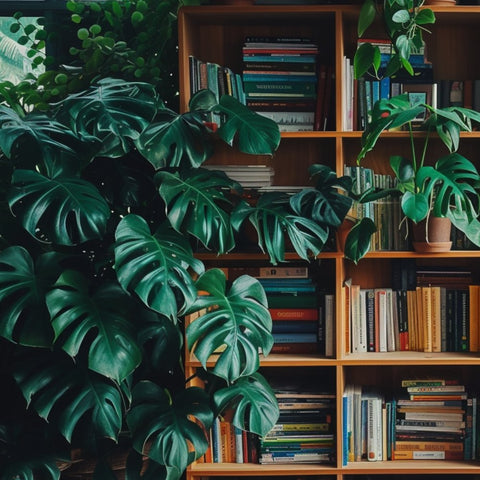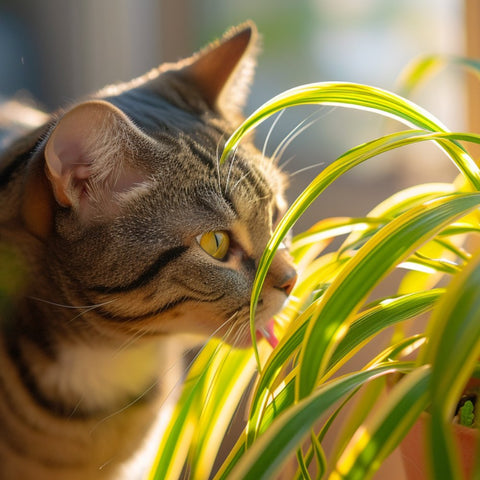Blog Post - Monstera plant
Looking to add a touch of tropical elegance to your indoor space? The Monstera plant is the perfect choice. With its unique leaf shape, iconic fenestrations, and climbing abilities, it's no wonder that Monstera plants have been gaining popularity in recent years. In this comprehensive guide, we'll explore the characteristics of the Monstera plant, the care and maintenance it requires, common issues and solutions, styling and decor ideas, and even some fun facts and myth debunking. Let's dive in!
Characteristics of the Monstera Plant

The Monstera plant, scientifically known as Monstera deliciosa, is a member of the Araceae family and is native to the tropical rainforests of Central America. Its large, glossy leaves are one of its most striking features. The leaves can grow up to 2 feet in diameter and have a unique shape, often described as heart-shaped or "elephant ear" shaped. What truly sets the Monstera plant apart is its iconic fenestrations, or the natural holes and splits that develop in the leaves as the plant matures. These fenestrations not only add to the plant's aesthetic appeal but also serve a purpose in the wild by allowing light to pass through the dense rainforest canopy.
Aerial roots are another characteristic of the Monstera plant. These roots have the ability to climb and attach themselves to surfaces, such as trees or moss poles. This climbing behavior can be utilized in indoor environments by providing a support structure for the plant to grow and spread its leaves. Additionally, the Monstera plant is known for its vigorous growth, often producing new leaves regularly in the right conditions.
Care and Maintenance of Monstera Plants
Light Requirements
When it comes to lighting, the Monstera plant prefers bright, indirect light. Direct sunlight can scorch its leaves, so it's best to place your Monstera plant a few feet away from a south or west-facing window. If your house has limited natural light, you can also supplement it with artificial grow lights placed at a suitable distance from the plant.
Watering

The key to watering a Monstera plant is finding the right balance. Overwatering can lead to root rot, while underwatering can cause the leaves to droop and dry out. It's important to let the top few inches of soil dry out between watering sessions. When you water, make sure to thoroughly saturate the soil and allow any excess water to drain away. Using well-draining soil and pots with drainage holes can help prevent waterlogging.
Temperature and Humidity
The ideal temperature range for a Monstera plant is between 60-85°F (15-29°C). However, it can tolerate slightly cooler temperatures for short periods. It's important to avoid placing the plant in areas with drafts or temperature extremes, such as near heaters or air conditioning vents. As for humidity, the Monstera plant thrives in moderately high humidity. If your home has dry air, you can increase humidity by misting the leaves, using a humidifier, or placing the plant on a tray filled with water and pebbles.
Pruning and Propagation

To keep your Monstera plant looking its best, regular pruning is recommended. This involves removing any dead or yellowing leaves, as well as trimming back unruly vines to maintain a desired shape. Pruning can also help stimulate new growth. If you'd like to propagate your Monstera plant, it can be easily done through stem cuttings. Simply cut a healthy section of stem with a few nodes, place it in water or moist soil, and wait for roots to develop before transferring it to its own pot.
Common Issues and Solutions
Pest Infestations
Despite their hardiness, Monstera plants can be susceptible to common pests such as spider mites, mealybugs, and scale insects. If you notice any signs of infestations, such as webbing, tiny brown spots, or sticky residue on the leaves, it's important to take action promptly. Treatment options range from using natural remedies, such as neem oil or insecticidal soap, to introducing beneficial predatory insects like ladybugs.
Leaf Problems

Yellowing leaves or brown spots on Monstera plants can be caused by a variety of factors, including overwatering, underwatering, or nutrient deficiencies. It's important to carefully assess the plant's watering schedule and adjust accordingly. Providing the right balance of nutrients through regular fertilization can also help prevent leaf problems. Using a balanced, water-soluble fertilizer specifically formulated for houseplants is recommended.
Overwatering and Root Rot

Overwatering is one of the most common issues faced by Monstera plant owners, often leading to root rot. To prevent overwatering, it's crucial to ensure that the soil is well-draining and that the pot has drainage holes. Additionally, adjusting the watering frequency based on the plant's specific needs and the environmental conditions is important. If you suspect root rot, it's advisable to remove the affected portions of the plant and repot it in fresh, well-draining soil.
Styling and Decor Ideas with Monstera Plants
With its lush and tropical appearance, the Monstera plant is a versatile addition to any interior decor. Whether you have a modern, minimalist space or a cozy, bohemian-inspired room, the Monstera plant can effortlessly complement various styles. Here are a few ideas to incorporate Monstera plants into different spaces:
- In the living room: Place a large Monstera plant in a decorative pot as a statement piece near a couch or in an empty corner.
- In the office: Add a smaller Monstera plant to your desk or place it on a bookshelf to bring a touch of nature to your workspace.
- In the bathroom: Create a spa-like atmosphere by hanging a Monstera plant in a macrame hanger or placing it on a shelf near the bathtub.
Potting arrangements can also enhance the aesthetic appeal of your Monstera plant. Consider pairing it with other houseplants that have complementary colors or textures. You can also add decorative elements such as pebbles, moss, or decorative rocks to the soil surface for added visual interest.
Fun Facts and Myth Debunking
Did you know that Monstera plants produce edible fruits? These fruits, known as Monstera deliciosa, are often called "Swiss cheese fruits" due to their resemblance to the leaves. They have a unique flavor profile, described as a combination of pineapple, banana, and mango. However, it's important to note that the fruits are only safe to consume when fully ripe, as unripe fruits can cause throat irritation.
There are also a few myths surrounding Monstera plants that need debunking. One popular myth is that they have the ability to purify indoor air. While plants in general can improve air quality to some extent, the idea that Monstera plants specifically have exceptional air-purifying properties is not backed by scientific evidence. However, their lush foliage and aesthetic appeal can create a calming and inviting atmosphere in any space.
Conclusion
In summary, the Monstera plant is a captivating tropical houseplant that can breathe life into any indoor space. By understanding its characteristics, providing proper care and maintenance, and incorporating it creatively into your decor, you can enjoy the beauty and elegance of this beloved plant. Whether you're a seasoned plant enthusiast or a beginner, the Monstera plant's versatility and easy-going nature make it a fantastic addition to any plant collection. So why not bring a touch of the tropics into your home with a Monstera plant today?





























Comments (0)
There are no comments for this article. Be the first one to leave a message!